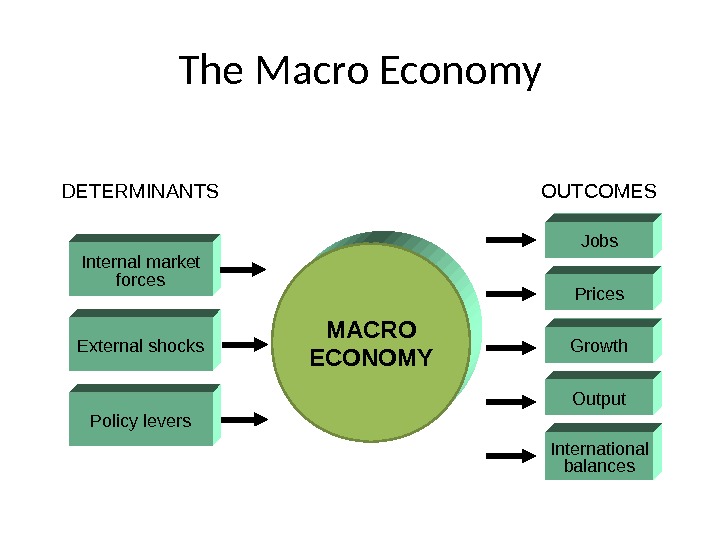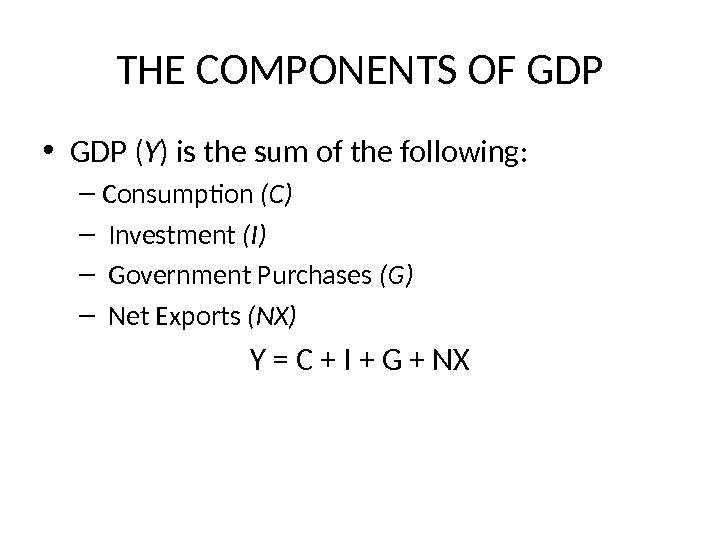Measuring a Nation’s Income Measuring a Nation’s




























- Размер: 520.5 Кб
- Количество слайдов: 27
Описание презентации Measuring a Nation’s Income Measuring a Nation’s по слайдам
 Measuring a Nation’s Income
Measuring a Nation’s Income
 Measuring a Nation’s Income • Microeconomics – Microeconomics is the study of how individual households and firms make decisions and how they interact with one another in markets. • Macroeconomics – Macroeconomics is the study of the economy as a whole. – Its goal is to explain the economic changes that affect many households, firms, and markets at once.
Measuring a Nation’s Income • Microeconomics – Microeconomics is the study of how individual households and firms make decisions and how they interact with one another in markets. • Macroeconomics – Macroeconomics is the study of the economy as a whole. – Its goal is to explain the economic changes that affect many households, firms, and markets at once.
 DETERMINANTS OUTCOMES MACRO ECONOMY Policy levers. Internal market forces External shocks Output Jobs Prices Growth International balances. The Macro Economy
DETERMINANTS OUTCOMES MACRO ECONOMY Policy levers. Internal market forces External shocks Output Jobs Prices Growth International balances. The Macro Economy
 Measuring a Nation’s Income • Macroeconomics answers questions like the following: – Why is average income high in some countries and low in others? – Why do prices rise rapidly in some time periods while they are more stable in others? – Why do production and employment expand in some years and contract in others?
Measuring a Nation’s Income • Macroeconomics answers questions like the following: – Why is average income high in some countries and low in others? – Why do prices rise rapidly in some time periods while they are more stable in others? – Why do production and employment expand in some years and contract in others?
 THE ECONOMY’S INCOME AND EXPENDITURE • When judging whether the economy is doing well or poorly, it is natural to look at the total income that everyone in the economy is earning.
THE ECONOMY’S INCOME AND EXPENDITURE • When judging whether the economy is doing well or poorly, it is natural to look at the total income that everyone in the economy is earning.
 THE ECONOMY’S INCOME AND EXPENDITURE • For an economy as a whole, income must equal expenditure because: – Every transaction has a buyer and a seller. – Every dollar of spending by some buyer is a dollar of income for some seller.
THE ECONOMY’S INCOME AND EXPENDITURE • For an economy as a whole, income must equal expenditure because: – Every transaction has a buyer and a seller. – Every dollar of spending by some buyer is a dollar of income for some seller.
 THE MEASUREMENT OF GROSS DOMESTIC PRODUCT • Gross domestic product (GDP) is a measure of the income and expenditures of an economy. • It is the total market value of all final goods and services produced within a country in a given period of time.
THE MEASUREMENT OF GROSS DOMESTIC PRODUCT • Gross domestic product (GDP) is a measure of the income and expenditures of an economy. • It is the total market value of all final goods and services produced within a country in a given period of time.
 THE MEASUREMENT OF GROSS DOMESTIC PRODUCT • The equality of income and expenditure can be illustrated with the circular-flow diagram.
THE MEASUREMENT OF GROSS DOMESTIC PRODUCT • The equality of income and expenditure can be illustrated with the circular-flow diagram.
 The Circular-Flow Diagram Spending Goods and services bought. Revenue Goods and services sold Labor, land, and capital Income = Flow of inputs and outputs = Flow of dollars. Factors of production Wages, rent, and profit FIRMS • Produce and sell goods and services • Hire and use factors of production • Buy and consume goods and services • Own and sell factors of production HOUSEHOLDS • Households sell • Firms buy. MARKETS FOR FACTORS OF PRODUCTION • Firms sell • Households buy MARKETS FOR GOODS AND SERVICES
The Circular-Flow Diagram Spending Goods and services bought. Revenue Goods and services sold Labor, land, and capital Income = Flow of inputs and outputs = Flow of dollars. Factors of production Wages, rent, and profit FIRMS • Produce and sell goods and services • Hire and use factors of production • Buy and consume goods and services • Own and sell factors of production HOUSEHOLDS • Households sell • Firms buy. MARKETS FOR FACTORS OF PRODUCTION • Firms sell • Households buy MARKETS FOR GOODS AND SERVICES
 THE MEASUREMENT OF GROSS DOMESTIC PRODUCT • GDP is the market value of all final goods and services produced within a country in a given period of time.
THE MEASUREMENT OF GROSS DOMESTIC PRODUCT • GDP is the market value of all final goods and services produced within a country in a given period of time.
 THE MEASUREMENT OF GROSS DOMESTIC PRODUCT • “ GDP is the Market Value. . . ” – Output is valued at market prices. • “. . . Of All Final. . . ” – It records only the value of final goods, not intermediate goods (the value is counted only once). • “. . . Goods and Services. . . “ – It includes both tangible goods (food, clothing, cars) and intangible services (haircuts, housecleaning, doctor visits).
THE MEASUREMENT OF GROSS DOMESTIC PRODUCT • “ GDP is the Market Value. . . ” – Output is valued at market prices. • “. . . Of All Final. . . ” – It records only the value of final goods, not intermediate goods (the value is counted only once). • “. . . Goods and Services. . . “ – It includes both tangible goods (food, clothing, cars) and intangible services (haircuts, housecleaning, doctor visits).
 THE MEASUREMENT OF GROSS DOMESTIC PRODUCT • “. . . Produced. . . ” – It includes goods and services currently produced, not transactions involving goods produced in the past. • “ . . . Within a Country. . . ” – It measures the value of production within the geographic confines of a country.
THE MEASUREMENT OF GROSS DOMESTIC PRODUCT • “. . . Produced. . . ” – It includes goods and services currently produced, not transactions involving goods produced in the past. • “ . . . Within a Country. . . ” – It measures the value of production within the geographic confines of a country.
 THE MEASUREMENT OF GROSS DOMESTIC PRODUCT • “. . . In a Given Period of Time. ” – It measures the value of production that takes place within a specific interval of time, usually a year or a quarter (three months).
THE MEASUREMENT OF GROSS DOMESTIC PRODUCT • “. . . In a Given Period of Time. ” – It measures the value of production that takes place within a specific interval of time, usually a year or a quarter (three months).
 THE COMPONENTS OF GDP • GDP includes all items produced in the economy and sold legally in markets.
THE COMPONENTS OF GDP • GDP includes all items produced in the economy and sold legally in markets.
 THE COMPONENTS OF GDP • What Is Not Counted in GDP? – GDP excludes most items that are produced and consumed at home and that never enter the marketplace. – It excludes items produced and sold illicitly, such as illegal drugs.
THE COMPONENTS OF GDP • What Is Not Counted in GDP? – GDP excludes most items that are produced and consumed at home and that never enter the marketplace. – It excludes items produced and sold illicitly, such as illegal drugs.
 THE COMPONENTS OF GDP • GDP ( Y ) is the sum of the following: – Consumption (C) – Investment (I) – Government Purchases (G) – Net Exports (NX) Y = C + I + G + NX
THE COMPONENTS OF GDP • GDP ( Y ) is the sum of the following: – Consumption (C) – Investment (I) – Government Purchases (G) – Net Exports (NX) Y = C + I + G + NX
 THE COMPONENTS OF GDP • Consumption (C) : – The spending by households on goods and services, with the exception of purchases of new housing. • Investment (I) : – The spending on capital equipment, inventories, and structures, including new housing.
THE COMPONENTS OF GDP • Consumption (C) : – The spending by households on goods and services, with the exception of purchases of new housing. • Investment (I) : – The spending on capital equipment, inventories, and structures, including new housing.
 THE COMPONENTS OF GDP • Government Purchases (G) : – The spending on goods and services by local, state, and federal governments. – Does not include transfer payments because they are not made in exchange for currently produced goods or services. • Net Exports (NX): – Exports minus imports.
THE COMPONENTS OF GDP • Government Purchases (G) : – The spending on goods and services by local, state, and federal governments. – Does not include transfer payments because they are not made in exchange for currently produced goods or services. • Net Exports (NX): – Exports minus imports.
 GDP and Its Components (An example)
GDP and Its Components (An example)

 GDP AND ECONOMIC WELL-BEING • GDP is the best single measure of the economic well-being of a society. • GDP person tells us the income and expenditure of the average person in the economy.
GDP AND ECONOMIC WELL-BEING • GDP is the best single measure of the economic well-being of a society. • GDP person tells us the income and expenditure of the average person in the economy.
 GDP AND ECONOMIC WELL-BEING • Higher GDP person indicates a higher standard of living. • GDP is not a perfect measure of the happiness or quality of life, however.
GDP AND ECONOMIC WELL-BEING • Higher GDP person indicates a higher standard of living. • GDP is not a perfect measure of the happiness or quality of life, however.
 GDP AND ECONOMIC WELL-BEING • Some things that contribute to well-being are not included in GDP. – The value of leisure. – The value of a clean environment. – The value of almost all activity that takes place outside of markets, such as the value of the time parents spend with their children and the value of volunteer work.
GDP AND ECONOMIC WELL-BEING • Some things that contribute to well-being are not included in GDP. – The value of leisure. – The value of a clean environment. – The value of almost all activity that takes place outside of markets, such as the value of the time parents spend with their children and the value of volunteer work.
 GDP, Life Expectancy, and Literacy Copyright© 2004 South-Western
GDP, Life Expectancy, and Literacy Copyright© 2004 South-Western
 Summary • Because every transaction has a buyer and a seller, the total expenditure in the economy must equal the total income in the economy. • Gross Domestic Product (GDP) measures an economy’s total expenditure on newly produced goods and services and the total income earned from the production of these goods and services.
Summary • Because every transaction has a buyer and a seller, the total expenditure in the economy must equal the total income in the economy. • Gross Domestic Product (GDP) measures an economy’s total expenditure on newly produced goods and services and the total income earned from the production of these goods and services.
 Summary • GDP is the market value of all final goods and services produced within a country in a given period of time. • GDP is divided among four components of expenditure: consumption, investment, government purchases, and net exports.
Summary • GDP is the market value of all final goods and services produced within a country in a given period of time. • GDP is divided among four components of expenditure: consumption, investment, government purchases, and net exports.
 Summary • GDP is a good measure of economic well-being because people prefer higher to lower incomes. • It is not a perfect measure of well-being because some things, such as leisure time and a clean environment, aren’t measured by GDP.
Summary • GDP is a good measure of economic well-being because people prefer higher to lower incomes. • It is not a perfect measure of well-being because some things, such as leisure time and a clean environment, aren’t measured by GDP.

